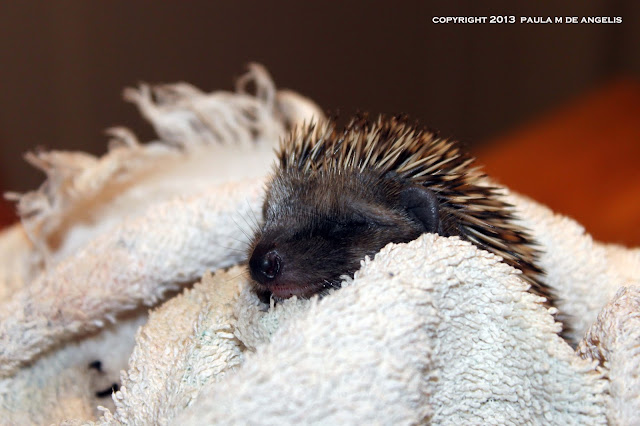Who would
have thought that I could lose my heart to a little baby hedgehog? To be
honest, I had never seen a hedgehog before last Thursday evening. I had heard
of them, but they were mostly small creatures who populated children’s books; The
Tale of Mrs. Tiggy-Winkle in the book by Beatrix Potter comes to mind. Beatrix
Potter used her pet hedgehog Tiggy-Winkle as inspiration for her story. It is
so coincidental that we were just in Beatrix Potter country—England’s Lake
District--on vacation. Last Thursday evening we found an adorable baby hedgehog
(pinnsvin in Norwegian) on our way home from the boat, either abandoned by its
mother or perhaps mother and baby got separated by accident. It was struggling
to survive, so we took her home, washed her and fed her with some sugar water,
after talking to the hedgehog experts at Pinnsvinhjelpen.no. They suggested we feed
her cat food, egg yolk mixed with sugar water, and lactose-free heavy cream,
and emphasized that she needed to be kept warm during the night. So we
followed their advice and the following morning (Friday) she was awake and
hungry. A visit to Jette at Pinnsvinhjelpen in Ski on Saturday afternoon was
very productive; she gave us dry cat food (among other useful items) that she told us to mix with hot
water so that it got mushy. She was certain that Hedgie (the name we gave the
little hedgehog) would love this mix, and she was so right. Hedgie not only
liked to eat this, but she ‘anointed’ herself with small bits of it;
self-anointing is a hedgehog behavior that is not well understood. Hedgehogs
will place small bits of chewed food on their backs; possible explanations are
that this is a way of perfuming themselves, or that they like the taste of something
new and this is a way of acknowledging that. Whatever the reason, it is
humorous to watch them do this, and I filmed her doing this while she ate her
cat food mush (http://youtu.be/kPgHYgTCdwA).
I wasn’t
prepared for how attached I got to this little creature. She stole my heart
with her wobbly gait, desire to be held, desire to snuggle and to burrow into
the crook of your arm, how she would fall asleep in your hand, her cute little
face, her trusting nature, her sweetness, her wild scent. Mealtimes were a
treat—just to watch her tramp around in the cat food mush and then afterwards
to dip her in lukewarm water to wash off most of what was stuck to her. She was
with us until Sunday afternoon, at which time we drove her to her new home, a
farm in southwest Norway, where her new family lives. Here there will be a
garden for Hedgie to wander around in eventually, and possibly there will be
other hedgehogs to join her at some point. Perhaps Hedgie will become a mother herself
one day. That would be a good thing, since these little creatures are on the
endangered species list here in Norway, and are now protected by law. It is
possible to keep them as indoor pets, but it would not be fair to them. In our
case, we would not be able to offer her a garden or even a terrace, and that
would not be best for her. But how I wanted to keep her.
It’s not
surprising that I’d never seen a hedgehog before; they are not native to the
Americas. And even though hedgehogs have thousands of spines on their backs
like porcupines, they are not related to them at all. They have more in common
with shrews according to what I’ve read online. Hedgehogs are omnivorous,
meaning that they will eat berries and melon as well as insects, snails (e.g. the brown snails that infest many of the gardens in east Norway) and frogs. They can live for up to
seven years. They are nocturnal animals; born blind, their eyes will open fully
at around four weeks. Hedgie was about three weeks old when we found her, so
she would open her eyes briefly from time to time. She weighed 100 grams last
Thursday; her new family just informed me that her weight is up to 105 grams, a
good sign. She is eating and she is happy. And that makes me happy, even though
yesterday when we came home to an empty apartment—without Hedgie—I was not at
all happy. I missed her incredibly. I’m posting some photos of her; it won’t
take you long to figure out why I lost my heart to her.

















































